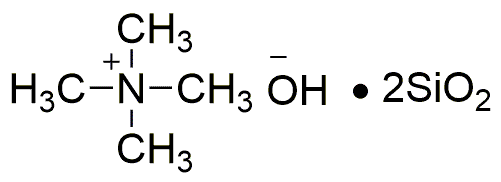Tetramethylammonium silicate solution, 15-20 wt. % in H2O is widely utilized in research focused on:
- Silicate Ceramics Production: This chemical is essential in the manufacturing of silicate ceramics, which are used in various applications such as tiles, pottery, and dental materials due to their durability and aesthetic appeal.
- Surface Coatings: It serves as a precursor in producing advanced surface coatings that enhance the durability and scratch resistance of materials, making it valuable in industries like automotive and electronics.
- Nanotechnology: Researchers leverage its properties to create silica nanoparticles, which have applications in drug delivery systems and as additives in cosmetics for improved texture and stability.
- Environmental Remediation: The solution is used in processes aimed at removing heavy metals from wastewater, providing an eco-friendly approach to pollution control in industrial settings.
- Adhesives and Sealants: It is incorporated into formulations for adhesives and sealants, enhancing their bonding strength and thermal stability, which is crucial in construction and manufacturing sectors.
General Information
Properties
Safety and Regulations
Applications
Tetramethylammonium silicate solution, 15-20 wt. % in H2O is widely utilized in research focused on:
- Silicate Ceramics Production: This chemical is essential in the manufacturing of silicate ceramics, which are used in various applications such as tiles, pottery, and dental materials due to their durability and aesthetic appeal.
- Surface Coatings: It serves as a precursor in producing advanced surface coatings that enhance the durability and scratch resistance of materials, making it valuable in industries like automotive and electronics.
- Nanotechnology: Researchers leverage its properties to create silica nanoparticles, which have applications in drug delivery systems and as additives in cosmetics for improved texture and stability.
- Environmental Remediation: The solution is used in processes aimed at removing heavy metals from wastewater, providing an eco-friendly approach to pollution control in industrial settings.
- Adhesives and Sealants: It is incorporated into formulations for adhesives and sealants, enhancing their bonding strength and thermal stability, which is crucial in construction and manufacturing sectors.
Documents
Safety Data Sheets (SDS)
The SDS provides comprehensive safety information on handling, storage, and disposal of the product.
Product Specification (PS)
The PS provides a comprehensive breakdown of the product’s properties, including chemical composition, physical state, purity, and storage requirements. It also details acceptable quality ranges and the product's intended applications.
Certificates of Analysis (COA)
Search for Certificates of Analysis (COA) by entering the products Lot Number. Lot and Batch Numbers can be found on a product’s label following the words ‘Lot’ or ‘Batch’.
Numéro de catalogue
Numéro de lot/série
Certificates Of Origin (COO)
This COO confirms the country where the product was manufactured, and also details the materials and components used in it and whether it is derived from natural, synthetic, or other specific sources. This certificate may be required for customs, trade, and regulatory compliance.
Numéro de catalogue
Numéro de lot/série
Safety Data Sheets (SDS)
The SDS provides comprehensive safety information on handling, storage, and disposal of the product.
DownloadProduct Specification (PS)
The PS provides a comprehensive breakdown of the product’s properties, including chemical composition, physical state, purity, and storage requirements. It also details acceptable quality ranges and the product's intended applications.
DownloadCertificates of Analysis (COA)
Search for Certificates of Analysis (COA) by entering the products Lot Number. Lot and Batch Numbers can be found on a product’s label following the words ‘Lot’ or ‘Batch’.
Numéro de catalogue
Numéro de lot/série
Certificates Of Origin (COO)
This COO confirms the country where the product was manufactured, and also details the materials and components used in it and whether it is derived from natural, synthetic, or other specific sources. This certificate may be required for customs, trade, and regulatory compliance.

